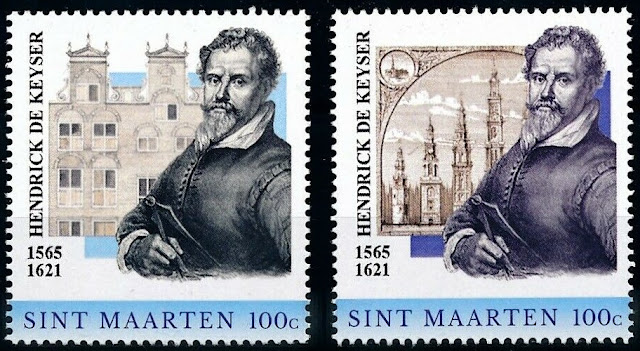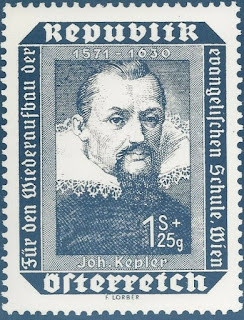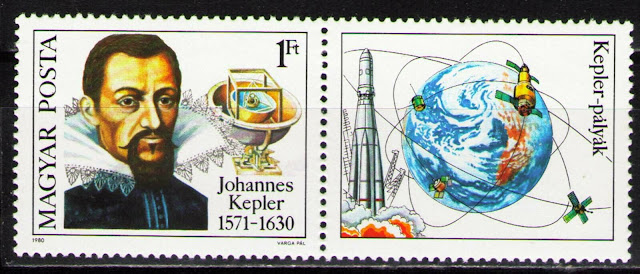1565 Born: Hendrick de Keyser, Dutch sculptor and architect born in Utrecht (d. 1621)
Hendrick de Keyser (15 May 1565 – 15 May 1621) was a Dutch sculptor and architect born in Utrecht, Netherlands, who was instrumental in establishing a late Renaissance form of Mannerism in Amsterdam. He was the father of Thomas de Keyser who was an architect and portrait painter.
De Keyser is famous for a number of important buildings which belong to the core of Dutch historic sites. Today the Zuiderkerk (1603-1611) and accompanying tower (1614), the Delft Town Hall (1618-1620), the Westerkerk (1620-1631) and Westertoren (built in 1638 but in a modified version) are among the historic buildings which provide important insights into De Keyser's work. His Commodity Exchange of 1608-1613 was pulled down in the 19th century.
Hendrick de Keyser's projects in Amsterdam during the early decades of the 17th century helped establish a late Mannerist style referred to as "Amsterdam Renaissance". The Amsterdam Renaissance style deviates in many respects from sixteenth-century Italian Renaissance architecture. Classical elements such as pilasters, cornices and frontons were used on a large scale, but mainly as decorative elements. De Keyser never slavishly followed the tenets of classical architecture as laid down in the Italian treatises. His version came to full bloom at the end of the second decade of the 17th century, and set the stage for the later Dutch classical phase of Jacob van Campen and Pieter Post. The East India House in Amsterdam was most likely also designed by him.
Stamps Issued by Sint Maarten commemorating Hendrick de Keyser
1618 – Johannes Kepler confirms his previously rejected discovery of the third law of planetary motion
Kepler's laws of planetary motion are three scientific laws describing the motion of planets around the Sun, published by Johannes Kepler between 1609 and 1619. These improved the heliocentric theory of Nicolaus Copernicus, replacing its circular orbits and epicycles with elliptical trajectories, and explaining how planetary velocities vary. The laws state that:
- The orbit of a planet is an ellipse with the Sun at one of the two foci.
- A line segment joining a planet and the Sun sweeps out equal areas during equal intervals of time.
- The square of the orbital period of a planet is directly proportional to the cube of the semi-major axis of its orbit.
The elliptical orbits of planets were indicated by calculations of the orbit of Mars. From this, Kepler inferred that other bodies in the Solar System, including those farther away from the Sun, also have elliptical orbits. The second law helps to establish that when a planet is closer to the Sun, it travels faster. The third law expresses that the farther a planet is from the Sun, the longer its orbit, and vice versa.
Johannes Kepler (December 27, 1571 – November 15, 1630) was a German astronomer, mathematician, and astrologer. He is a key figure in the 17th-century scientific revolution, best known for his laws of planetary motion, and his books Astronomia nova, Harmonices Mundi, and Epitome Astronomiae Copernicanae. These works also provided one of the foundations for Newton's theory of universal gravitation.
Kepler was a mathematics teacher at a seminary school in Graz, where he became an associate of Prince Hans Ulrich von Eggenberg. Later he became an assistant to the astronomer Tycho Brahe in Prague, and eventually the imperial mathematician to Emperor Rudolf II and his two successors Matthias and Ferdinand II. He also taught mathematics in Linz, and was an adviser to General Wallenstein. Additionally, he did fundamental work in the field of optics, invented an improved version of the refracting (or Keplerian) telescope, and was mentioned in the telescopic discoveries of his contemporary Galileo Galilei. He was a corresponding member of the Accademia dei Lincei in Rome.
Kepler lived in an era when there was no clear distinction between astronomy and astrology, but there was a strong division between astronomy (a branch of mathematics within the liberal arts) and physics (a branch of natural philosophy). Kepler also incorporated religious arguments and reasoning into his work, motivated by the religious conviction and belief that God had created the world according to an intelligible plan that is accessible through the natural light of reason. Kepler described his new astronomy as "celestial physics", as "an excursion into Aristotle's Metaphysics", and as "a supplement to Aristotle's On the Heavens", transforming the ancient tradition of physical cosmology by treating astronomy as part of a universal mathematical physics
Stamps from Austria, Germany and Hungary featuring Johannes Kepler
1859 Born: Pierre Curie, French physicist and academic, Nobel Prize laureate (d. 1906)
Pierre Curie (15 May 1859 – 19 April 1906) was a French physicist, a pioneer in crystallography, magnetism, piezoelectricity, and radioactivity. In 1903, he received the Nobel Prize in Physics with his wife, Marie Skłodowska-Curie, and Henri Becquerel, "in recognition of the extraordinary services they have rendered by their joint researches on the radiation phenomena discovered by Professor Henri Becquerel".
French stamp depicting Pierre and Marie Curie
Bulgarian stamp depicting Pierre Curie






No comments:
Post a Comment